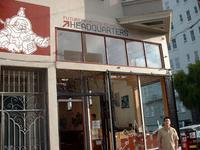Future Primitive Closes its Doors

From The Guardian
At the top of the bad-news charts last week was the recent shuttering of Future Primitive Sound's gallery and shop in the Lower Haight. The head of the collective and label, Mark Herlihy, pointed to a set of sickening circumstances that led him to close the doors: The store lost one of its main suppliers of spray paints and art supplies, the lifeblood of the enterprise, and Herlihy's investor withdrew from a second round of funding. Now, with so-called Bay Area hyphy perched on the verge, Herlihy, one of the pioneers in the hip-hop DJ party scene, is reconsidering all his options.
"I've been fighting for so long — I'm starting to think I'll do something different," he said last week over the phone while on the road. "I'm hitting that point where — I've been putting in 150 percent since I was 17 years old. But the long and short of it is it takes money to make money, and in this case, I was trying to see a vision through, and I was real close to it."
Why does this event rate so high on the bummer-o-meter? The Future Primitive storefront was the center of a certain unique breed of Bay Area underground hip-hop. Not only did Future Primitive put out solid and influential discs like Romanowski's recent Steady Rocking and Z-Trip and Radar's 1999 rap-and-rock mixdown, Live at the Future Primitive Soundsession, Vol. 2, but Herlihy has also been instrumental in fostering turntable-shaking collaborations such as Cut Chemist and DJ Shadow's 7-inch showdown (which led to their Brainfreeze disc). Furthermore, he created his own distinctive synthesis when he invited graf artists like Doze to perform alongside DJs and later exhibited visual artists like Brian Barneclo and Mike Giant alongside those mix CDs and hoodies.
While friends have offered to pitch in for a benefit, that won't necessarily help with consistent funding, he adds, joking, "There's no shortage of broke-ass artists out there!" When it came down to it, "all I was trying to do was give an outlet to a lot of my friends, and this new movement of art that I was seeing and believed in." As for the gallery and store, Herlihy says, "I don't want to put a Band-Aid on a big wound — either do it right or not do it at all. I know what the store needs in order to become successful. It's a matter of whether I can find somebody to make that happen."


0 Comments:
Post a Comment
<< Home